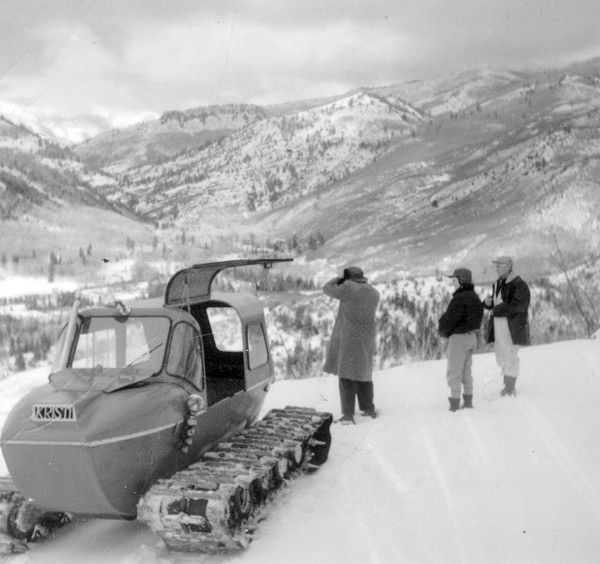KT3survivor
Active member
I borrowed this from the vail daily archives, found via the kristi website. if you have only driven thru vail on I-70 and never been to the top of the back bowls, its hard to appreciate the drastic terrain change or the scale of the place. i bet a long bumpy ride in that kt2 changed alot of minds about what kind of skiing was possible back then.
http://www.vaildaily.com/news/1960-the-hausemans-arrive-in-vail/

this pictue is probably the roaring fork valley, not gore creek valley, but still a cool photo.
http://www.vaildaily.com/news/1960-the-hausemans-arrive-in-vail/
Our involvement had begun a few months earlier when a man named Peter Seibert visited us in Cleveland and asked us to invest $5,000 in land on which he wanted to build a ski village and lifts. He showed us home movies of some beautiful Colorado “High Country,” but little else.
We took Pete to our golf club and were surprised at what a good golfer he was – but we were not impressed with the ski-resort idea. Still, $5,000 wasn’t that much money, and we decided to take a chance. It was a chance that changed our lives.
Like many of the early investors, I was a committed vacation skier. I first took to the ski slopes in Aspen in 1948. After three days on beginner terrain, Blanche, who was an expert, decided that I was ready for the Roche Run, a famous downhill racing trail. I can remember the experience with painful clarity. A few hours felt like three days until we finally reached the bottom.
Oh well, the bruises went away and I was hooked. For several years after that experience, Blanche and I skied in Sun Valley, Idaho, and in the summer of 1959, Pete visited us, giving us a glimpse of what could happen in the Vail Valley. Shortly after that, I was appointed to the first board of directors. Now here we were, coming to Colorado, curious and excited about this new venture.
Interstate 70 didn’t exist in 1960. We drove west out of Denver on U.S. Highway 6, a winding, two-lane road that passed through the old mining towns of Idaho Springs and Georgetown and then up over Loveland Pass and down into the Snake and Blue River valleys. We traveled through the town of Dillon, where the reservoir sits now, and then over Vail Pass.
Then the road dropped rapidly into a narrow valley – the Gore Creek Valley – where a small stream meandered through rolling meadows. Smoke was curling up out of the chimneys of cabins that were tucked into pine groves along the valley floor. The day was warm and sunny and there was still plenty of snow, but there was not even a hint of the spacious open slopes on the back side of the mountain.
We made a left turn onto a dirt road, crossed a small wooden bridge over Gore Creek, and met Earl Eaton, the person who discovered Vail. Earl was an Eagle County native, and he was planning to drive us up the mountain in the red Kristi Kat, an early version of a “snowcat.” Earl was the man who had shown Seibert the open meadows on the other side of the mountain and convinced him that this was perfect terrain for a ski resort. To this day, Eaton says it was the red Kristi Kat that sold Vail.
We climbed into the Kat. Earl shifted into gear and headed up the old logging road that followed Mill Creek through aspen groves. Then we traversed back through a lodgepole and spruce forest into open glades. There was another spruce forest on the summit, where we interrupted a blue grouse in the middle of its spring mating ritual. We had climbed a little more than 3,000 vertical feet in about two and a half hours. The snow depth had increased from 14 inches on the valley floor to more than 9 feet at the top.
The “front,” or north side of the mountain, looked like it would offer some good skiing when the trails were cut through the forests. What really amazed us, though, was the “back” of the mountain. It was a beautiful sight – one I will never forget! Looking out from the summit, we could see several open bowls side by side. Long, smooth slopes plummeted downward where skiers could make big, sweeping turns. Only a few trees offered relief to the vast expanses. I took some 16mm films.
This was truly a skier’s paradise, and at that time I had no way of knowing how profoundly Vail would affect my life, or how intimately I would become involved in the creation of one of the world’s premier ski resorts.
Editor’s Note: In a continued effort to help the community understand its roots, the Vail Daily for a second time is serializing Dick Hauserman’s “The Inventors of Vail.” This is the first installment, an excerpt from chapter one, “Before Vail.” The book is available at Verbatim Booksellers, The Bookworm of Edwards, Pepi’s Sports, Gorsuch Ltd. and The Rucksack, as well as other retailers throughout the valley.

this pictue is probably the roaring fork valley, not gore creek valley, but still a cool photo.
